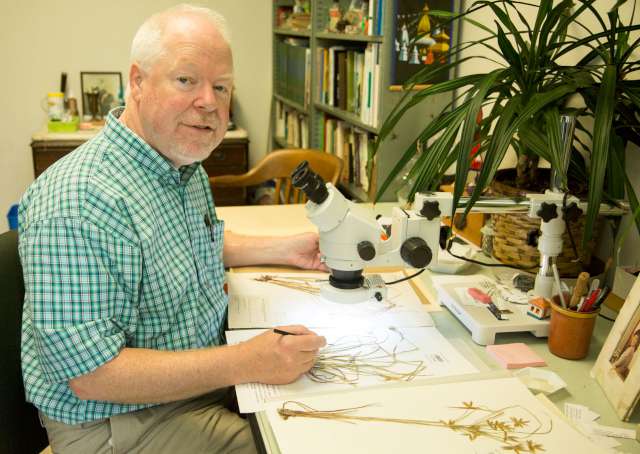
Newly-Discovered Plant Species Named After EIU Professor

Published on August 22 2016 10:45 am
Last Updated on August 22 2016 10:45 am
Gordon Tucker doesn’t remember doing so, but he’s been told that as a toddler, he could not keep his hands off the nearby vegetation.
“My mother told me that I would reach over the edge of my stroller or through the bars of my play pen, reaching out for any plant that I could get my hands on,” he said. “And that I was transplanting garden seedlings before I could walk.”
(GORDON TUCKER)
Decades later, Tucker – now a skilled botanist and long-time faculty member at Eastern Illinois University -- continues to “reach out” in his study of plants. His area for study, however, now stretches a lot further than a toddler’s arm.
Known primarily as a vascular plant systematist, Tucker specializes in what is known as the sedge family, flowering plants which outwardly resemble grasses and rushes. The family is large with some 5,500 known species, many of which can be found in Asia and South America.
Since entering the field of botany professionally in the late 1970s, Tucker has published dozens of papers and monographs on the sedges of North America, Venezuela and Brazil. Working in collaboration with the Missouri Botanical Garden and the Chinese National Academy of Sciences, he conducts research for the Flora of China, a scientific publication aimed at describing plants native to China. He has also extensively studied the native plants of Illinois in collaboration with EIU students.
Additionally, along with fellow Eastern professor Zhiwei Liu, he co-teaches a study abroad course, Plant Usage and Culture in China.
It’s no wonder, then, that Tucker was excited to learn earlier this year that not only had another new species in the sedge family been discovered, but that the botanists who made the discovery had decided to name the plant -- Fimbristylis tuckeri – after him. The official announcement was made in the September 2016 issue of the Kew Bulletin, a leading international journal for the botanical community and published by the Royal Botanic Garden near London.
Tucker explained that a group of botanists discovered the plant while exploring the Western Ghats, an Indian mountain range. They suspected it was a newly discovered species, but didn’t have the expertise in that family of plants to confirm those suspicions. Fortunately, having done extensive work in that field, Tucker did.
“A find like this is not so unusual,” he said. “Over 1,000 new plant species worldwide were identified in 2015.”
Differences between plant species may be subtle. It could be the slightest variance in the DNA, or looks, of a plant – in the stem, the leaves, the flowers – that is detected only through magnification via a dissecting microscope. Or, the chemistry could be different, causing a slight change in the smell of the plant, Tucker said.
Traditionally, the person or group of persons who discovers a new plant species gets the honor of naming it. “I’ve named discoveries I’ve made after professors I’ve known,” Tucker said. “I’m flattered that this group of researchers would name their discovery after me.”
Tucker said he’s the second EIU professor to have a plant species named after him. The first was EIU professor emeritus John Ebinger, whose Ebinger’s Wild-rye grass (Elymus ebingeri) was published in 1997 in Harvard Papers in Botany. (Now in his early 80s, Ebinger, who “retired” from teaching in 1995, continues to reside in Charleston and remains active with botanical research on campus and the Illinois Natural History Survey.)
Upon his arrival on Eastern’s campus in 1996, Tucker succeeded Ebinger as curator of what is now known as the Stover-Ebinger Herbarium, a part of Eastern’s Department of Biological Sciences.
The herbarium, which maintains a large collection of preserved plant specimens and associated data used for scientific study, was originally named the Stover Herbarium for Ernest L. Stover, professor of botany at EIU from 1923-1960. It received its expanded name to honor Ebinger, who collected about half the specimens in the collection and served as curator from 1963-1995.
According to Tucker, the herbarium currently houses 82,000 plant specimens going back to 1906. And, it receives “lots of use” by both undergraduate and graduate students, as well as university faculty, each year.
That use will continue to grow as both the herbarium and the department strive to meet the changing needs and demands of Eastern’s students.
During the Fall 2016 semester, for example, Tucker is scheduled to introduce a new senior/graduate-level course – Medicinal Plants – that should be of particular interest to the growing number of pre-health students enrolled at the university. Course content will be a worldwide survey of both the past and present human utilization of plants and plant products as medicines, including their chemical constituents and natural and cultural history.
“I think it will be a course of particular interest, especially as we, as a society, continue to look to plants for different alternatives to the treatment of illness and disease, such as cancer,” Tucker said.
He plans, too, to share his knowledge with the general public through a free 90-minute workshop, Plant Usage and Civilization, made possible through Eastern’s Academy of Lifetime Learning. In the Nov. 2 session, he will describe the uses of plants for foods, medicines, cosmetics and other applications. Those interested in attending the event, to be held from noon to 1:30 p.m. in the Charleston Carnegie Public Library, should phone 581-5114 to register. Information can also be obtained through the academy’s website (https://www.eiu.edu/adulted/












